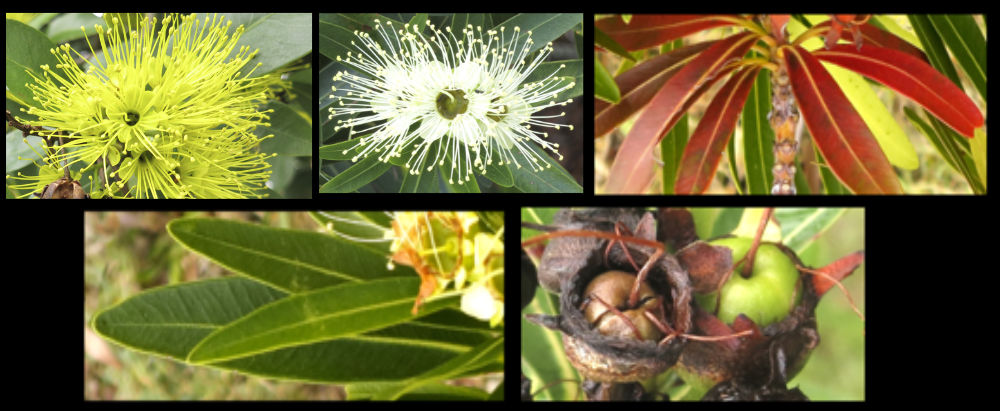Xanthostemon.
Family Myrtaceae > Subfamily Myrtoideae > Tribe Xanthostemoneae.
There are around 48 species with 13 or 14 from Australia including 11 from northern Queensland.
They are multi-stemmed shrubs or trees up to 15 or 20 m high.
Large old trees may have buttress roots.
The bark fissures and peels or flakes showing a cream, reddish or pale brown base.
Small twigs may have dense brown hairs and there may be hairs on the terminal buds.
The opposite or alternate leaves are crowded at the branch ends.
On petioles 0.5 to nearly 2 cm long the blades can be up to 18 cm long and 11 cm wide.
The ovate, elliptic or oblong blades have numerous close parallel side veins (penniveined).
They curve at the edge sometimes joining to form an intra-marginal vein.
Young leaves may have dense hairs while older ones tend to be smooth.
Oil dots are present and can be sparse to dense.
Terminal or axillary inflorescences are typically a dense cluster near the branch ends.
Some species have a solitary flower.
If bracts and bracteoles are present they are very small.
Individual flowers, 1 to 3 cm across are on a pedicel from 0.5 to 3 cm long.
The sepal and petal bases are fused to form a wide or narrow hypanthium (calyx tube).
The hypanthium can be up to around 6 mm long with 4 or 5 linear to triangular sepal lobes 2 to 3 mm long.
The lobes are often unequal and there are hairs and oil glands.
The 4 or 5 white or yellow spreading petals are 3 to 10 mm long.
They are round or ovate with a narrower claw base.
They may be smooth or hairy and oil glands are present.
There are many stamens with filaments up to 3 cm long.
They can be free or joined just at the base and in 1 or more whorls.
The red, yellow or orange filaments are often stiff.
The anthers are attached to a depression in the base of the connective between the thecae (pollen sacs).
Anthers open through longitudinal slits.
The ovary is fused to the hypanthium just at the base or for up to half its length.
Around 2 mm long the free part may be smooth or hairy and it has oil glands.
Each of the 2 to 6 locules has numerous ovules in a ring around a central placenta.
The single thin smooth yellow, cream or pale green style has a small stigma.
The fruit are a roughly spherical loculicidal capsule around 1 cm long.
The hypanthium and sepal lobes remain attached.
Each of the 3 or 4 (6) chambers has flat or angular seeds.
The numerous seeds are 2 to 5 mm long and may have a wing.
J.F.


